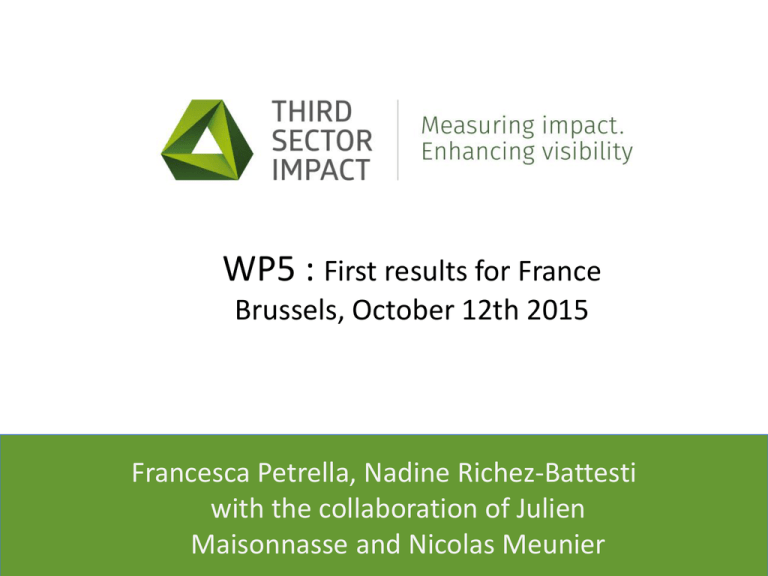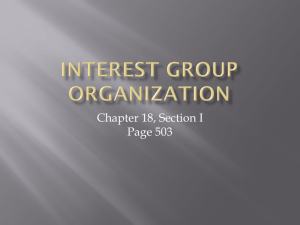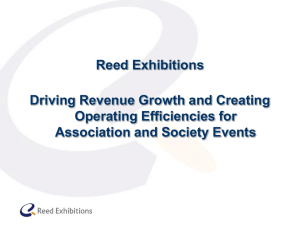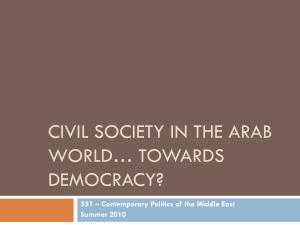Event title Place and date - Third Sector Impact Measuring impact
advertisement

WP5 : First results for France Brussels, October 12th 2015 Francesca Presenter(s)’ Petrella, Nadine affiliation(s) Richez-Battesti with the collaboration of Julien Maisonnasse and Nicolas Meunier Outline of the presentation The third sector at a glance Key barriers and how to get over ? Key findings Key findings per policy field Social services Culture Sport Case studies Policy recommendations Measuring impact. Enhancing visibility. The Third sector at a glance (1) Third sector in France = data on Social and Solidarity Economy (SSE) New law adopted in July 2014 : a major step toward recognition (will include some social enterprises) SSE : main characteristics (2011) 10% of total employment (2,3 millions of paid workers) A large majority of associations : • • • • 84% are associations (78% of employment within SSE) 12% are cooperatives (13% of SSE employment) 3% are mutual organizations (6% of SSE employment) 1% are foundations (3% of SSE employment) A large majority of very small organizations (64% have less than 5 jobs) and only 1% of very large ones (250 jobs or more) Between 11 to 14 millions of volunteers (that represent 1 072 000 FTE), most of them in sport and culture Measuring impact. Enhancing visibility. The Third sector at a glance (2) A dynamic sector in terms of job creation : Between 2008-2011, job creation of 1,4% (-0,2% in the whole economy) An issue of transmission of the project and a need to “replace” volunteers within the governance structure (generational renewal) A need to increase job quality : by comparison with the rest of the economy : Less full-time contracts Less long-term contracts More short-term contracts and unstable jobs Older workers (nearly 30% have more than 50 years) The renewal of the workforce is another real issue But higher overall job satisfaction and higher wage equity Measuring impact. Enhancing visibility. The Third sector at a glance (3) The third sector by chosen policy fields : Social services : SSE : 62% of employment in this field (mainly associations : 96% of SSE providers, 95% of employment) The main activity field for associations : 47% of associations are in social services Culture (performing arts) : SSE : 27% of employment in this field (mainly associations : 99,4% of SSE providers, 96% of employment) 6th activity field for associations Sport (and leisure activities) : SSE : 54% of employment in this field (mainly associations : 99,9% of SSE providers, 99,8% of employment) 5th activity field for associations => TSO’s are mainly associations in these three selected fields Measuring impact. Enhancing visibility. Key barriers and how to get over ? Legal environment A major step toward recognition by the recent law Administrative and legislative massive tome and complexity Subsector infrastructure Differences between activity fields Need for more adequate and coherent support Need to strengthen the lobbying forces Governance To rebuild a bicephalous governance and renew the board towards a more competence-based and strategic one Need for training for the volunteers and for decision –making tools Transmission of the project is a real issue Introduction of new committees to enlarge participation Personnel (Human resources) A lot of pressure on the director who need to be “rare bird” No problem of recruitment but high turnover Employment conditions are improving but there is still some progress to be made Managing volunteers and paid workers is not always easy Generational renewal Measuring impact. Enhancing visibility. Key barriers and how to get over ? (2) Finances Main tendency : reduction and diversification of public funds (tendering processes), need to mobilize other types of resources but no miracle solution One solution ? Organizational change : different forms of cooperation and concentration to reduce costs Institutional facilities Difficult to give a general picture given the great heterogeneity Image Not well visible for the general public Negative image (lack of professionalism, a thorn in the side) but slowly changing Inter-organizational linkages “Coopetition” : from cooperation to hard competition (sometimes) With the private commercial sector : end of the « ideological war » With the public authorities : considered as service providers, need to reinforce the links with public policies at different governance levels Measuring impact. Enhancing visibility. Key findings TSO’s in the 3 selected policy fields : A large majority of associations, although innovative cases use another legal form (scop, scic, association of employers to share resources in common) A large proportion of small organizations although there is a trend toward pooling, sharing and concentration A changing environment at the source of many barriers : A legislative and administrative environment more and more complex A more competitive environment The decrease and transformation of public funds A lot of common barriers : governance : re-build a bicephalous governance, competences of the board and of the director at stake human resources management and generational renewal finances : need for more diversification Image : need to build a more positive one Inter-organizational linkages : monitor cooperation processes and rebuild partnership with public authorities But differences in the degree of structuration of the sector (social services and sport well structured by contrast with culture) The existence of organizational innovations to overcome these barriers Measuring impact. Enhancing visibility. Key findings per policy field : Social services First activity field of the SSE and of associations 62% of employment in SSE 95% of employment in SSE are in associations Associations are the major employer in this field 33 000 SSE organizations with paid workers 717 000 FTE in SSE in 2011 Mainly women (74% of workers) Less full-time and long-term contracts than in the rest of the economy Includes : Help for disabled and dependent persons (adults and children) : home care and lodgings (ex. health care facilities, nursing homes, shelters ) Child care services Work integration organizations Other social services for persons in need Measuring impact. Enhancing visibility. Social services : major barriers Legal environment Well defined environment at the legislative level Evolution towards more participation of users and to more tendering processes Subsector infrastructure Sector well structured : a lot of umbrella organizations, a lot of support is proposed but Lack of coherence and visibility Need to adapt support to the evolution of the environment : need for decision-making tools Governance Bicephalous governance not easy to deal with : given the complexity of the environment, growing gap between volunteers of the board and the director : need for a more « strategic and competence-based board » Need for a generational renewal of volunteers in the boards Need to associate, at least partially, the employees The place of users is often highlighted (some participation is required by law) Personnel (Human resources) Hard task to be a director : need to be a hero, who keeps his social values and mission and combines them with technical and managerial skills, a lot of pressure on them Human resources management is not yet an issue for many associations that do not assume their « employer’s function » - things are changing slowly… No problem in recruitment but high turnover (not a lot of carrier perspective) Management of paid work and volunteers not always easy Measuring impact. Enhancing visibility. Social services : major barriers Finances A major barrier for associations : key issue : how to diversify their financial resources ? Two main trends in public funds: • a decrease of public subsidies • a transformation of public financing sources : more diversity (State, Region, municipalities and different services within the administration) and more tendering processes. Market resources : limited given the nature of the users Reliance on volunteer resources : limited by the need to professionalize Sponsoring and philanthropy : very little importance by now, only for one-shot projects, could not be the miracle solution, need time and competences Institutional facilities Large variety of situations General tendency towards cooperation and concentration (mergers) to reduce costs Associations do not have access to funds to invest into new technologies and innovations (by contrast with commercial enterprises) Image TSO’s are little known, not visible by the general public, they don’t make any difference Negative image by public authorities but it is slowly changing Inter-organizational linkages Cooperation between associations is strongly recommended by public authorities although there are competing for public markets : coopetition With private companies : barriers are breaking down With public authorities : associations are considered as services providers that answer to the public demand, loss of innovative capacity, very little co-building of public policies Measuring impact. Enhancing visibility. Key findings per policy field : Culture A very diversified sector : focus on cultural associations in performing arts A major field in the third sector : Culture = 6th activity sector within TSO’s in 2011. Main characteristics of the sector (2011) : 267 000 cultural associations (only 13% of them have at least one paid worker), average size is 5 employees per association : very small associations 169 000 FTE paid workers (9,4% of employment within associations). Less workers in long term contracts (30%) than the average of associations (47%); more short-term and unstable contracts (occasional workers) than the average : 40% against 22% Higher level of education : 65% of employees have a diploma of higher education (min bac+2), only 41% in the associative sector in general. 189000 FTE of volunteers, 20% of volunteers in associations in France Less dependency from public funds (40% of their budget) than associations on average (49%) Measuring impact. Enhancing visibility. Culture : major barriers Subsector infrastructure : Lack of structuration of cultural TSO’s : need for coordination and reinforcing lobbying and representativeness of this sector Need for technical support (project engineering) : large use of a public tool (dispositif local d’accompagnement) Need to strengthen the link between cultural TSO’s and the rest of the third sector Governance : Given the growing complexity of the environment, need to build a new internal governance, more strategic and more professionalized => training for volunteers ? Need to reinforce the collective dynamic within cultural associations (the artist used to be alone) Need to create new committees to strengthen participation of users Personnel (Human resources) : Difficulty to manage a diversity of employment contracts and forms : qualified work, subsidized low-skilled jobs, civic service contracts, occasional workers, High turnover within the teams, lack of job security, low wages Measuring impact. Enhancing visibility. Culture : major barriers Finances Need to diversify financing resources while making cultural activities accessible to all in a social inclusion and education perspective Multiplication of public sources of financing : very high administrative load Difficulty to get European funds Difficulty to get sponsorship (especially for small associations) Institutional facilities Not a major issue, in general organizations are well off Some delays as far as the use of digital technologies are concerned Image Need to increase visibility : cultural TSO’s are not known by the general public Inter-organizational linkages “Coopetition” between cultural TSO’s Opening toward partnership with private commercial enterprises Need to be considered as partners of public policy not only to be expected to answer to tendering processes and execute public orders Measuring impact. Enhancing visibility. Key findings per policy field : Sport A difficulty to estimate the number of sportive associations Globally, there were in 2012 at least 210 000 associations of 3 types : • Associative clubs (165 000), 100 federations (umbrella organisations) • Associations whose main activity is sport (10 000) • Associations whose secondary activity is sport (min 35 000) 31 000 associations have at least one paid worker (20% of employer’s associations) 80 000 paid workers, (around 60 000 FTE), 4,5% of total employment by associations 80% of employer’s associations have less than 3 paid workers Data for sport and leisure activities (2011): SSE : 78% of providers SSE : 54% of employment 5th activity field of SSE associations : 99,9% of SSE providers and 99,8% of the SSE employment Less long-term contracts and less full-time jobs (46%) A majority of men and young employees (more than 50% are less than 40 years old) : passion of the sport is a strong motivation Measuring impact. Enhancing visibility. Sport : major barriers Subsector infrastructure A very well structured sector (vertically and horizontally) : every association is affiliated to a departmental committee which is part of a regional committee ; each municipality has a local representative for sports but greats inequalities Umbrella organizations can provide support but this information is not well diffused among associations Sports facilities at disposal from municipalities (various degrees) Governance Bicephalous governance : not always easy ! Need for training for the directors given the context Personnel (human resources) The director has to be polyvalent but is not often trained to manage workers Management of volunteers and paid workers sometimes difficult Need for training of both volunteers and paid workers given the administrative and juridical complexity of this sector No major problem of recruitment, except in some rural or remote areas but high turnover rate Measuring impact. Enhancing visibility. Sport : major barriers Finances Need for diversification of resources (difficult to achieve) : • Public resources are decreasing (great effort via the CNDS – centre national de développement du sport – in the last 5 years to give public resources for the development of sport accessible to all and anchored in territorial policies, public funds to create skilled and long-term jobs) • Sponsoring is not always easy to get and is linked to the good results of the club or the media coverage (competition between club) • Increasing membership fees : limited solution if sport wants to be accessible to all Institutional facilities Large variety of situations : some sports need heavy investments while other don’t large dependency to local policies since municipalities are the major provider of sports facilities Need for sharing and pooling resources : the development of employers’ associations, to group some tasks and share paid workers, some tools are provided by the regional committee of sport Image Biased image by the reputation of large and successful clubs such as football clubs Image of the sportsman as passionate These images hide what is really done by sport associations at the territorial level in terms of social link and social development Inter-organizational linkages Rivalry between sports makes difficult to develop a transversal territorial project Entry of private commercial enterprises in some activity : kite surf, canoe, nature expeditions… Strong relationships between associations and local public authorities Measuring impact. Enhancing visibility. Case studies Social services Association of family home care services (Valréas) : family care, child care and care for the elderly, created in 1964, around 100 employees; Calme (Nice), clinic (against alcoholism therapy), cooperative (scop), created in 1981, 33 employees; La Varappe (Aubagne), WISE, Work integration and environment, 150 FTE, 1500 employees in integration (interim) accounting for 300 FTE; Culture Les Têtes de l’Art (Marseille), artistic mediation association : engineering participatory art projects, engineering and mutualisation platform, to pool and share resources; to foster networks and partnership between cultural, social, educational and economic actors coming from the same territory, created in 1996, 12 paid workers. Illusion Macadam (Montpellier) cooperative (collective interest cooperative SCIC), engineering of cultural support, 23 FTE, 34 members, created in 2001 Sport Sport Objectif Plus (Manosque), association, created in 1991, to consolidate employment in sport and in associations in general, 7 employees, 12 directors in the board Measuring impact. Enhancing visibility. Policy recommendations :first propositions Give more value and visibility to the impact of TSO’s in terms of employment, social inclusion, social cohesion and territorial and economical development, To simplify administrative processes (toward a unique file for subsidies per public authority) and to decompartmentalize between health and care services Need to support infrastructure and develop engineering and consulting : Support umbrella organizations to reinforce their representation and support mission Provide training to both volunteers and directors (strategic management, HRM, accounting, law) Support cooperation, pooling and sharing processes Foster the development of territorial projects Measuring impact. Enhancing visibility. Thank you for your attention. www.thirdsectorimpact.eu · participate@thirdsectorimpact.eu







